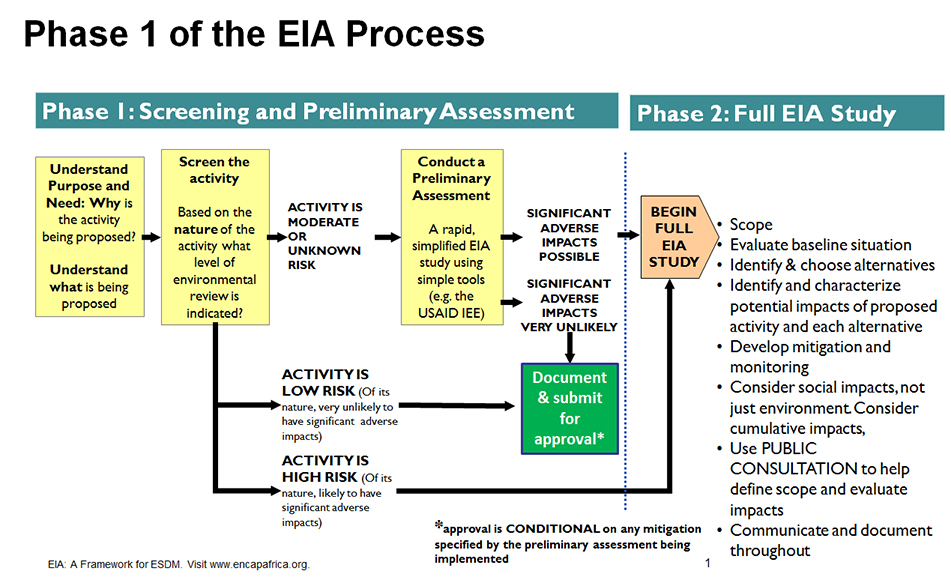- Environmental Procedures
- Environmental Compliance Officers
- Environmental Compliance Database (ECD)
- Safeguarding the Environment Over the Program Cycle
- 22 CFR 216: USAID's EIA Process
- Environmental Documentation: Types & Templates
- Mitigation, Monitoring & Reporting
- Environmental Compliance and Procurement
- Mission Processes; Roles and Responsibilities
- Environmental Procedures & Climate Risk Management
- Special Compliance Topics
- Principles of EIA
- Social Impact Assessment Principles
- Sectoral Environmental and Social Best Practices
- Biodiversity and Tropical Forest Analyses
- Training: Courses and Calendar
- Laws, Regulations and Policies
- Foreign Language Resources
- USAID Bureaus
- Safeguarding the Environment: Mission Support
- Europe & Eurasia
- Global Health
Speeches Shim
Overview
USAID’s environmental safeguards and procedures implement the internationally recognized Environmental Impact Assessment (EIA) process.
Familiarity with the general EIA process thus makes USAID’s procedures much easier to understand—and is required to effectively simultaneously satisfy USAID and host country EIA procedures, something that USAID staff and implementing partners are increasingly required to do.
Effective compliance during USAID project design and implementation requires an understanding of key EIA terms and concepts and the effective application of core EIA skills.
This section summarizes the EIA process and introduces key EIA concepts and skills, providing links to more detailed resources in each case.
The EIA Process Defined
EIA is a formal process for identifying:
- likely effects of activities or actions on the environment, and on human health and welfare.
- means and measures to mitigate and monitor these impacts
The basic elements and outline of the EIA process are essentially standardized internationally. However, each donor and host country government has its own specific implementation of the process.
Key Terms and Concepts of the EIA Process
Environment: The “environment” in EIA is not just the biophysical environment, but the social and cultural environment as well. EIA is concerned with the potential effects of activities on the biophysical environment, on societies and communities, and on human health and welfare.
Activity and Action: In the vocabulary of USAID’s program cycle, an activity managed by USAID typically has multiple actions, which are discrete interventions or desired accomplishments: e.g. a road, seedling production, or river diversion to irrigate land.
Accomplishing an action itself entails a set of elements or tasks. (For example, “market access road rehabilitation” is an action. Entailed tasks or elements include surveying, grading, culvert construction, compaction, etc.) The EIA process needs to be cognizant of the entailed tasks or elements but establishes the findings at the action level.
Baseline situation: The baseline situation are the existing environmental conditions (inclusive of human health and socio-cultural aspects) in the action area of influence in the absence of the proposed activity. Trends and variability are part of the baseline situation; it is not just a static snapshot in time. For example, this chart of groundwater levels shows both seasonal variability and a trend over time. BOTH are part of the groundwater baseline situation.
Impact: The change from the baseline situation caused by the action.
Mitigation: The design and implementation of measures to eliminate, reduce or offset the undesirable effects of a proposed action on the environment.
Monitoring: The essential complement of mitigation, monitoring is BOTH (1) determining whether mitigation is being implemented as required; and (2) determining whether mitigation is sufficient and effective.
Summary of the EIA Process
Note: more detailed overview available.
The EIA process consists of two main phases, as depicted in the diagram below.
- Screening or Preliminary Assessment
- Detailed EIA Study
Most ---but not all – USAID activities have low or moderate risks. For these activities, the EIA process goes no further than a preliminary assessment ). Only activities with significant potential adverse impacts go a detailed EIA study.
(Note: In USAID terminology, a preliminary assessment is an “Initial Environmental Examination” (IEE). A detailed EIA study is an “Environmental Assessment.” Host country EIA systems – with which USAID activities must also comply – will generally have different names for these documents.
Follow-through on the EIA process during activity implementation (not depicted in the diagram below) consists of IMPLEMENTING the mitigation measures identified by the EIA process and monitoring this implementation and its effectiveness.

Click image to view PDF version.
Core EIA Skills
Life-of-project compliance for USAID-funded activities requires effective application of the following core EIA skills:
- Characterizing the baseline situation, focusing on the aspects of the baseline situation likely to be affected by the proposed activity, or upon which the activity depends for its success.
- Identifying potential impacts of concern, starting by researching the set of impacts typical of actions in the sector, and determining which of these “typical impacts” are actually of concern in the specific action context.
- Designing mitigation measures, with an emphasis wherever practical on choices of technique, site, and other design measures that prevent impacts
- Designing monitoring activities to determine if mitigation is (1) implemented as specified; and (2) sufficient and effective.
Resources
The EIA process and key terms:
- Training presentation “EIA: Concepts, Process and Skills” PDF (1 MB)
- EIA Topic Briefing PDF (1 MB)
How USAID’s procedures implement the general EIA process: Training presentationEIA and USAID Environmental Procedures: the Initial Environmental Examination (IEE) and Beyond
Core EIA Skills: Characterizing the baseline situation and identifying impacts of concern:
- EIA: Concepts, Process and Skills PDF (1 MB)
- EIA Topic Briefing PDF (1 MB)
Core EIA Skills: Mitigation & Monitoring. Consult the Mitigation, Monitoring, and Reporting page.

Comment
Make a general inquiry or suggest an improvement.